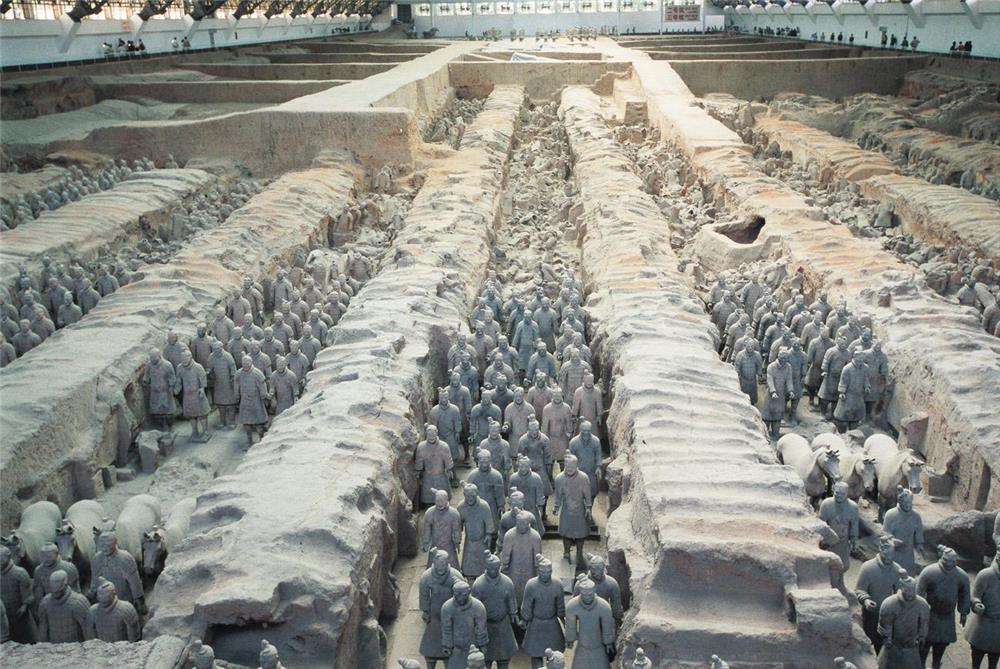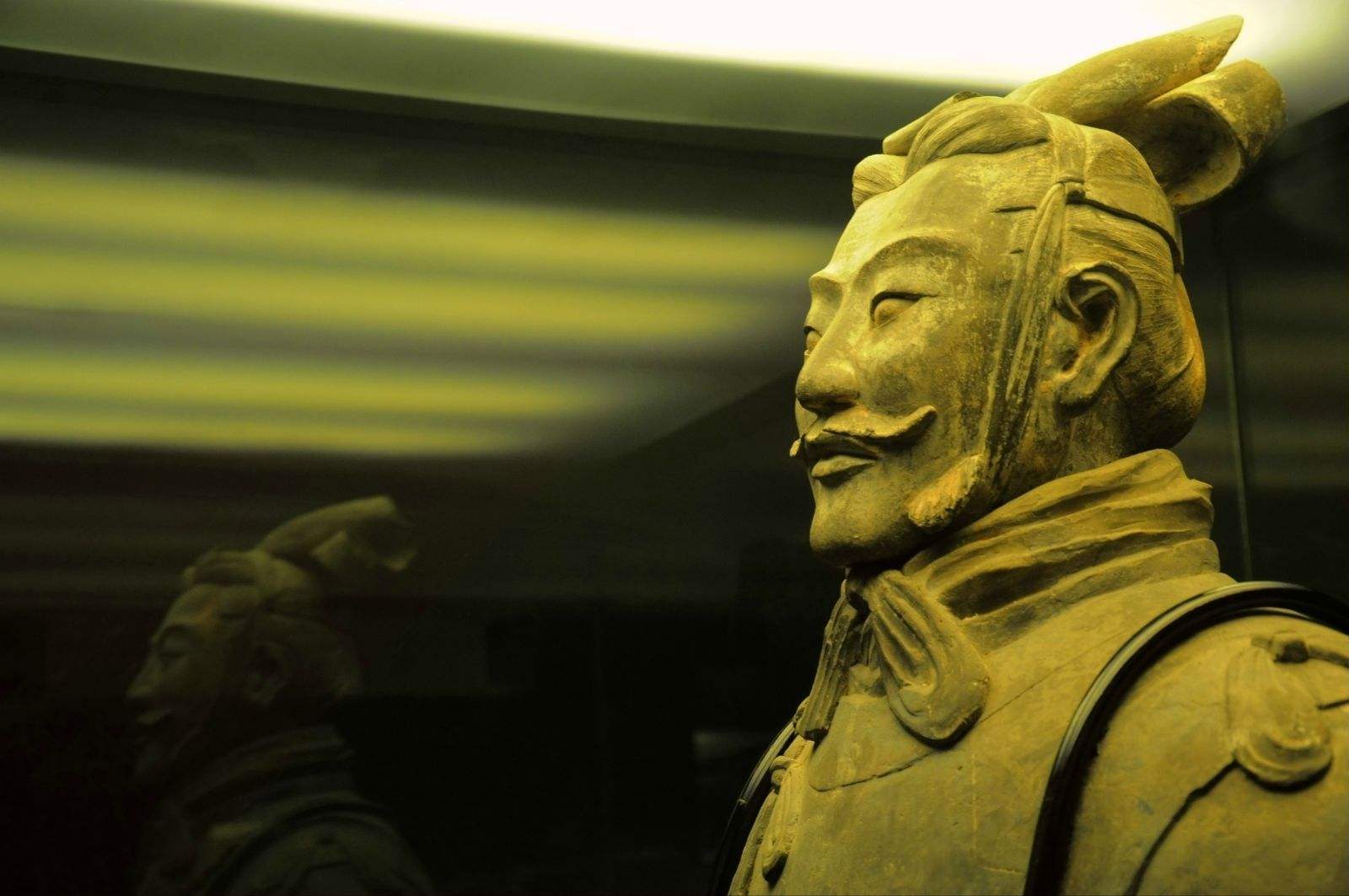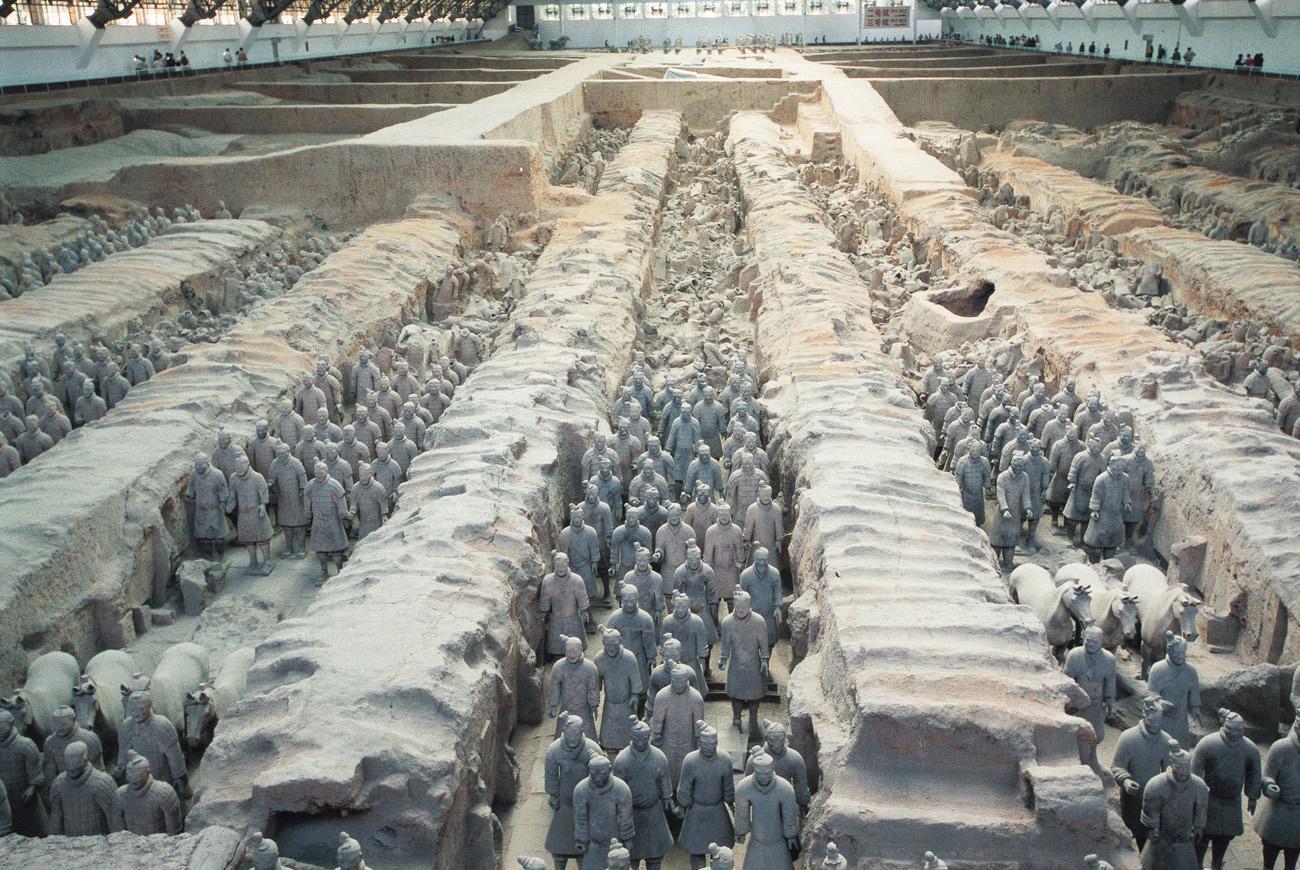24 Hours Hotline: +86 137-3541-1378
Email:[email protected]
24 Hours Hotline: +86 137-3541-1378
Email:[email protected]

Address: Room 1-2-2503, Taiyang Shuian Xincheng, #1 Xijing Road, Changan, Xi'an
Admission Fee: CNY120 for low season (Dec.1-Feb.29), CNY150 for high season (Mar.1-Nov.30)
Opening Hours: 8:30-18:30
Time for Visit: 3 hours
How to get there:
Bus Routes:
1. No. 914, 915, or Special Line 101, and get off at Terracotta Warriors Museum
2. No.306 or Tourist Line No.5 to get there, which costs 7 CNY and 1 hour.
Welcome to Xianprivatetour.com, we are the source in Xian and we are the official ticketing agent of Terracotta Warriors and Horses Museum Admission Ticket. Buy tickets online, Unbeatable Price! Easy to Pay! Easy to get the ticket!
General Introduction:
Known as "the Eight Wonders of the world", the museum shows a surprisingly high level in sculpture which is listed as the most significant discovery of the 20th century. It is a super large collection of life-size terra cotta sculptures in battle formations, reproducing the mega imperial guard troops of Emperor Qin Shi Huang (259 - 210BC), the first emperor of the first unified dynasty of Imperial China. Up to now, there has discovered a total of 179 accompanying burial pits of different connotations and various shapes in Emperor Qin's Mausoleum area.

History
Terracotta Warriors is a kind of ancient tomb sculpture. In ancient times, human sacrifice was practiced. Slaves were accessories of slave owners before their death. After their death, slaves were buried as martyrs for slave owners. The terra cotta warriors and horses are made into burial objects in the shape of soldiers (chariots, horses, soldiers).
During the Zhou Dynasty, the king of Zhou drew lessons from the tyranny of the Yin and Shang Dynasties, and emphasized the correct and moderate legal norms as the standard to govern the country.
After the promotion of the etiquette system of the Zhou Dynasty, the phenomenon of martyrdom was greatly limited. The system of martyrdom was formally abolished in the Qin Dynasty.
During the Spring and Autumn period and the Warring States period, the funeral custom changed qualitatively and began to be buried with "terra cotta figures". For example, pottery figurines, wooden figurines to replace. Since then, "terra cotta" has become a proper term for stone carvings and portraits. This is also the prototype of the terracotta warriors.
In July 1974, archaeologists began to excavate the pit of terracotta warriors in the east of the mausoleum of the first emperor of Qin Dynasty in Lintong County.
In December 1987, the mausoleum of the first emperor of Qin and terracotta warriors were listed in the world heritage list.

Top Things to Do in Terracotta Warriors and Horses
The main pit of the four which contain the discovered army measures 230 x 62 metres and is 4 to 6 metres deep. It had around 6,000 slightly larger than life-size depictions of infantrymen (1.8-1.9 metres tall), chariots and horses. The pit, originally with wooden columns supporting a wood beam ceiling, is partitioned by 10 brick-lined corridors. The floor was made from compacted earth which was then paved with over 250,000 ceramic tiles. The second pit, which is slightly smaller and R-shaped, had some 1,400 figures in it. In keeping with an obvious attempt to recreate exactly a real army, pit 3, measuring 21 x 17 metres, contains commanders and resembles a command post in the field.
To protect his tomb or perhaps even to ensure he had a handy bodyguard in the next life, Shi Huangdi went a whole lot better than his predecessors. Rulers in ancient China commonly had two or three statues to stand as guardians outside their tombs but Huangdi went for a whole army of them. The Terracotta Army is actually one of only four in all likelihood as that portion so far excavated - 1.5 km distant from the mausoleum - is on the eastern side and is probably duplicated on the other three sides of the tumulus. Even this one-quarter section has not been fully excavated with only three of its four pits having been fully explored by archaeologists.
Pits
Four main pits approximately 7 metres (23 ft) deep have been excavated. These are located approximately 1.5 kilometres (0.93 mi) east of the burial mound. The soldiers within were laid out as if to protect the tomb from the east, where all the Qin Emperor's conquered states lay.
Pit one, which is 230 metres (750 ft) long and 62 metres (203 ft) wide, contains the main army of more than 6,000 figures. Pit one has 11 corridors, most of which are more than 3 metres (10 ft) wide and paved with small bricks with a wooden ceiling supported by large beams and posts. This design was also used for the tombs of nobles and would have resembled palace hallways when built. The wooden ceilings were covered with reed mats and layers of clay for waterproofing, and then mounded with more soil raising them about 2 to 3 metres (6 ft 7 in to 9 ft 10 in) above the surrounding ground level when completed.
Pit two has cavalry and infantry units as well as war chariots and is thought to represent a military guard. Pit three is the command post, with high-ranking officers and a war chariot. Pit four is empty, perhaps left unfinished by its builders.
Some of the figures in pit one and two show fire damage, while remains of burnt ceiling rafters have also been found. These, together with the missing weapons, have been taken as evidence of the reported looting by Xiang Yu and the subsequent burning of the site, which is thought to have caused the roof to collapse and crush the army figures below. The terracotta figures currently on display have been restored from the fragments.
Other pits that formed the necropolis also have been excavated. These pits lie within and outside the walls surrounding the tomb mound. They variously contain bronze carriages, terracotta figures of entertainers such as acrobats and strongmen, officials, stone armour suits, burials sites of horses, rare animals and labourers, as well as bronze cranes and ducks set in an underground park.
Warrior figures
The terracotta figures are life-sized. They vary in height, uniform, and hairstyle in accordance with rank. The faces appear different for each individual figure, scholars however have identified 10 basic face shapes. The figures are of these general types: armored warriors; unarmored infantrymen; cavalrymen who wear a pillbox hat; helmeted driver of chariots with more armor protection; spear-carrying charioteers; kneeling archers who are armored; standing archers who are not; as well as generals and other lower-ranking officers. There are however many variations in the uniforms within the ranks, for example, some may wear shin pads while others not; they may wear either long or short trousers, some of which may be padded; and their body armors vary depending on rank, function, and position in formation. There are also terracotta horses placed among the warrior figures.
Originally, the figures were painted with bright pigments, variously coloured pink, red, green, blue, black, brown, white and lilac. The coloured lacquer finish and individual facial features would have given the figures a realistic feel. However, much of the colour coating had flaked off or become greatly faded.
Some scholars have speculated a possible Hellenistic link to these sculptures, due to the lack of life-sized and realistic sculptures prior to the Qin dynasty. They argued that potential Greek influence is particularly evident in some terracotta figures such as those of acrobats, as well as the technique used for casting bronze sculptures.
Construction
The terracotta army figures were manufactured in workshops by government laborers and local craftsmen using Terracotta Warriors1.jpglocal materials. Heads, arms, legs, and torsos were created separately and then assembled by luting the pieces together. When completed, the terracotta figures were placed in the pits in precise military formation according to rank and duty. The faces were created using molds, and at least ten face molds may have been used. Clay was then added after assembly to provide individual facial features to make each figure appear different. It is believed that the warriors' legs were made in much the same way that terracotta drainage pipes were manufactured at the time. This would classify the process as assembly line production, with specific parts manufactured and assembled after being fired, as opposed to crafting one solid piece and subsequently firing it. In those times of tight imperial control, each workshop was required to inscribe its name on items produced to ensure quality control. This has aided modern historians in verifying which workshops were commandeered to make tiles and other mundane items for the terracotta army.
Weaponry
Most of the figures originally held real weapons such as spears, swords, or crossbows, and the use of actual weapons would have increased the figures' realism. Most of the original weapons, however, were looted shortly after the creation of the army, or have rotted away. Nevertheless, many weapons such as swords, spears, lances, battle-axes, scimitars, shields, crossbows, and arrowheads have been found in the pits. Over 40,000 bronze items of weaponry have been recovered from the pits, with most of these arrowheads which are usually found in bundles of 100 units. Studies of these arrowheads suggests that they were produced in small units of self-sufficient, autonomous workshops that produced finished items in a production process referred to as cellular production or Taoism. There are also hundreds of crossbow triggers, and smaller number of other weapons such as bronze swords, and daggers.
Some of these weapons, such as the swords, are sharp and were coated with a 10–15 micrometre layer of chromium dioxide that kept the swords rust-free for 2,000 years. The swords contain an alloy of copper, tin, and other elements including nickel, magnesium, and cobalt. Some carry inscriptions that date their manufacture to between 245 and 228 BCE, indicating that they were used as weapons before their burials.
An important element of the army is the chariot, of which four types were found. In battle the fighting chariots formed pairs at the head of a unit of infantry. The principal weapon of the charioteers was the ge or dagger-axe, an L-shaped bronze blade mounted on a long shaft and used for sweeping and hooking at the enemy. Infantrymen also carried ge on shorter shafts, ji or halberds and spears and lances. For close fighting and defence, both charioteers and infantrymen carried double-edged straight swords. The archers carried crossbows, with sophisticated trigger mechanisms, capable of shooting arrows farther than 800 metres (2,600 ft).

How to Book the Admission Ticket
1. Send us Inquiry E-mail for booking
2. Pay by PayPal/Alipay/Wechat Pay/Bank account transfer...
3. Get the "Booking Confirmation" email
4. Get the ticket at the entrance of the show place or delivery to the address you provide
Payment
Pay by PayPal
PayPal provides a way to send money to anyone in the world who has an email address. But, first you have to register your details (including Credit Card details) with PayPal. As part of this process you decide on a password so that you are the only one who can access your PayPal account. For more details, plz refer to www.paypal.com
However the 4% transfer fee charged by PayPal will be added. That is, you have to pay: Quotation Amount + 4% serveice fee
Our PayPal Account is: [email protected]
Pay upon Delivery and Get the Ticket (in Xian)
If all options do not suit you, pay upon delivery in Xian should be your last choice! We will send one person bring you the ticket and wait you at the entrance of the show place. It's free for delivery!
Cancellation Policy!!!
Cancellation due to irresistible cause like Natural Disaster Coverage, facility is closed due to unforeseen circumstances, and Political Reasons.
Wechat: Chinaprivatetour
24 Hours Hotline:
+86 137-3541-1378
* Authentic Experiences: Genuine local experiences that immerse you in the true essence of Xi'an and beyond.
* Safety First: Highest safety standards with secure activities and reliable transportation.
* Customizable Tours: Flexible itineraries tailored to your interests and needs.
* Local Expertise: In-depth knowledge of Xi'an and China, offering exclusive insights.
* Professional Guides: Licensed bilingual guides with over 5 years of experience.
* Comfortable Travel: Experienced drivers and well-maintained vehicles for a smooth journey.
* Sustainable Tourism: Commitment to responsible tourism and supporting local communities.
* Customer-Focused: Personalized service and continuous improvement based on your feedback.
* Free Cancellation: Cancel up to 24 hours before travel for flexibility and peace of mind.
* 24/7 Support: Round-the-clock assistance for any questions or help needed.
(Your Privacy is Protected)
1 to 1 tailor-made service from our professional travel advisors for the most sophisticated
Constantly excellent reviews for attraction, hotel and service Competitive price
Local experts provide quality tours Best selected knowledgeable local guides Authentic local restaurants
7*24 hours available to create you a worry-free tour. No Hidden Fees and absolutely no pressure to buy. Secured









Copyright © 2017 www.xianprivatetour.com All rights reserved. 浙ICP备18056007号-6